Boost Individual Experience with Cutting-Edge Mobile Optimization
Boost Individual Experience with Cutting-Edge Mobile Optimization
Blog Article

The Ultimate Guide to Mobile Optimization: Techniques for Enhancing Web Site Performance on Smartphones and Tablets
The approaches for improving website performance on mobile systems go past simple adjustment; they incorporate a thorough technique that entails receptive design, speed optimization, content approaches, and user experience enhancements. By delving right into the complexities of mobile optimization, businesses can not only meet user assumptions yet additionally stay in advance in an affordable electronic landscape.
Importance of Mobile Optimization
Mobile optimization plays an essential duty in improving individual experience and driving conversion rates in the ever-evolving digital landscape. With the enhancing use mobile phones and tablets for searching the internet, ensuring that web sites are enhanced for mobile tools has actually come to be crucial for businesses - Mobile Optimization. A mobile-optimized website not only adapts seamlessly to different display sizes however also loads swiftly, providing individuals with a smooth and delightful surfing experience
In today's fast-paced globe, individuals anticipate instant access to information on the go. A website that is not maximized for smart phones risks losing potential clients due to reduce loading times or an inadequate user interface. By spending in mobile optimization, organizations can provide to the demands of their mobile audience, bring about greater involvement and raised conversions.
Furthermore, online search engine like Google prioritize mobile-friendly websites in their rankings, making mobile optimization necessary for improving exposure and bring in organic website traffic. Mobile Optimization. On the whole, the importance of mobile optimization can not be overemphasized, as it directly influences customer complete satisfaction, conversion prices, and total company success in the digital world
Responsive Design Methods
Implementing responsive layout techniques ensures that websites dynamically readjust their design and content based on the customer's device display size, supplying a consistent customer experience across different systems. One of the most typical methods made use of in receptive layout is creating fluid grids that permit web content to resize proportionally to the screen dimension. This guarantees that elements on the web page maintain their relative spacing and arrangement, maximizing the watching experience for users on different devices.
Furthermore, utilizing flexible pictures that can scale with the size of the viewport helps avoid images from being chopped or misshaped on smaller screens. CSS media inquiries play a crucial duty in receptive style by permitting designers to use certain designs based upon the device qualities such as screen width, height, and alignment. By leveraging media queries, sites can adjust their format and style to fit mobile phones, tablets, and desktop computer screens effortlessly.
Including responsive design techniques not just enhances customer experience however additionally adds to enhanced search engine positions, as online search engine like Google focus on mobile-friendly internet sites in their mobile search engine result. By accepting receptive style, internet sites can provide to the diverse needs of customers accessing web content on a range of gadgets, eventually driving interaction and conversions.
Speed and Performance Optimization

One key strategy is maximizing photos and multimedia content to minimize documents sizes without jeopardizing high quality. Compressing photos, leveraging modern image layouts like WebP, and lazy loading offscreen images are reliable approaches to quicken lots times (Mobile Optimization). Furthermore, minimizing HTTP demands, leveraging internet browser caching, and minimizing server feedback times are critical steps in boosting performance.
Applying a web content delivery network (CDN) can likewise substantially enhance website rate by distributing web content throughout several servers globally, decreasing latency for individuals accessing the site from various areas. Prioritizing critical above-the-fold web content and delaying non-essential scripts can better improve regarded efficiency. By concentrating on important source rate and efficiency optimization, internet sites can deliver a seamless and satisfying individual experience on mobile tools.
Mobile-Friendly Web Content Techniques
Mobile-friendly material strategies entail tailoring the discussion of info to match the smaller displays click here for more and on-the-go nature of smartphone and tablet computer customers. Additionally, breaking up content into much shorter paragraphs and utilizing bullet factors can assist boost readability and make it much easier for customers to take in details rapidly.
Including engaging visuals, such as pictures and video clips maximized for mobile viewing, can likewise enhance the total user experience. These visuals should be relevant, premium, and lots promptly to stop users from wearying. Furthermore, integrating interactive components like quizzes, surveys, or surveys can improve customer engagement and encourage active involvement.
Customer Experience Enhancements
Building on the structure of mobile-friendly web content strategies, boosting user experience requires enhancing every touchpoint to ensure smooth communication and satisfaction for mobile customers. One critical element of improving user experience on mobile gadgets is guaranteeing fast loading times.
Optimizing types for mobile customers by decreasing the number of areas and utilizing auto-fill functions can also enhance the total customer experience. By concentrating on these individual experience improvements, internet sites can efficiently engage and preserve mobile site visitors.
Verdict
In verdict, mobile optimization is essential for improving internet site efficiency on smartphones and tablet computers. By implementing responsive layout strategies, enhancing speed and efficiency, developing mobile-friendly material, and boosting user experience, businesses can properly reach and engage with their mobile target market. It is crucial for web sites to adjust to the boosting mobile usage fads in order to stay competitive in the electronic landscape.
Report this page